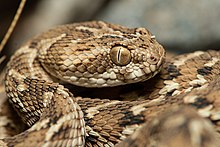Echis carinatus sochureki is a venomous viper subspecies[4] found in India, Pakistan, Afghanistan, Iran, and parts of the Arabian Peninsula.
| Echis carinatus sochureki | |
|---|---|

| |
| Scientific classification | |
| Domain: | Eukaryota |
| Kingdom: | Animalia |
| Phylum: | Chordata |
| Class: | Reptilia |
| Order: | Squamata |
| Suborder: | Serpentes |
| Family: | Viperidae |
| Genus: | Echis |
| Species: | |
| Subspecies: | E. c. sochureki
|
| Trinomial name | |
| Echis carinatus sochureki Stemmler, 1969
| |
| Synonyms[1] | |
Etymology
editThe subspecific name, sochureki, is in honor of Austrian herpetologist Erich Sochurek (1923–1987).[3]
Description
editThe head of E. c. sochureki is covered with small scales, except for 3-4 enlarged supraoculars. Midbody there are 29-33 rows of keeled dorsal scales. The keels of the middorsal rows are flat.[2]
The dorsal color pattern consists of a tan, grayish, or brown ground color with a central series of 30 whitish (never yellowish) blotches with dark brown edges. The flanks are marked with a row of wide arcs with distinct dark spots. The belly is whitish, with dark gray flecks. The head has a light arrow mark directed towards the snout. A light loreal stripe extends towards the angle of mouth.[2]
Geographic range
editEchis carinatus sochureki is found in Northern India, Pakistan, southern Afghanistan, south and central Iran, the United Arab Emirates, and Oman.[5]
The Wildlife of Pakistan website gives the range as northern India, Pakistan (except the high mountains in north), southern Afghanistan, central Iran to the coast of the Iranian Gulf and Khuzestan.[2]
The type locality is "West Pakistan, Ban Kushdil Khan bei Pishin" (Pishin, West Pakistan).[1]
Reproduction
editEchis carinatus sochureki is Viviparous
References
edit- ^ a b McDiarmid RW, Campbell JA, Touré TA (1999). Snake Species of the World: A Taxonomic and Geographic Reference, Volume 1. Washington, District of Columbia: Herpetologists' League. 511 pp. ISBN 1-893777-00-6 (series). ISBN 1-893777-01-4 (volume).
- ^ a b c d Saw-scaled Viper, ... at Wildlife of Pakistan, Accessed 3 August 2006.
- ^ a b Beolens, Bo; Watkins, Michael; Grayson, Michael (2011). The Eponym Dictionary of Reptiles. Baltimore: Johns Hopkins University Press. xiii + 296 pp. ISBN 978-1-4214-0135-5. (Echis sochureki, pp. 248, 253).
- ^ "Echis carinatus sochureki". Integrated Taxonomic Information System. Retrieved 3 August 2006.
- ^ Mallow D, Ludwig D, Nilson G (2003). True Vipers: Natural History and Toxinology of Old World Vipers. Malabar, Florida: Krieger Publishing Company. 359 pp. ISBN 0-89464-877-2.
Further reading
edit- Cherlin VA (1990). ["A taxonomic revision of the snake genus Echis (Viperidae). II. An analysis of taxonomy and description of new forms"]. [Proc. Zool. Inst. Leningrad ] 207: 193–223. (in Russian).
- Stemmler O (1969). "Die Sandrasselotter aus Pakistan: Echis carinatus sochureki subsp. nov." Aquaterra 6 (10): 118–125. (in German).
External links
edit- Echis carinatus at the Reptarium.cz Reptile Database. Accessed 2 August 2007.
- Echis sochureki sochureki Stemmler, 1969 at Tomáš Mazuch. Accessed 24 November 2007.